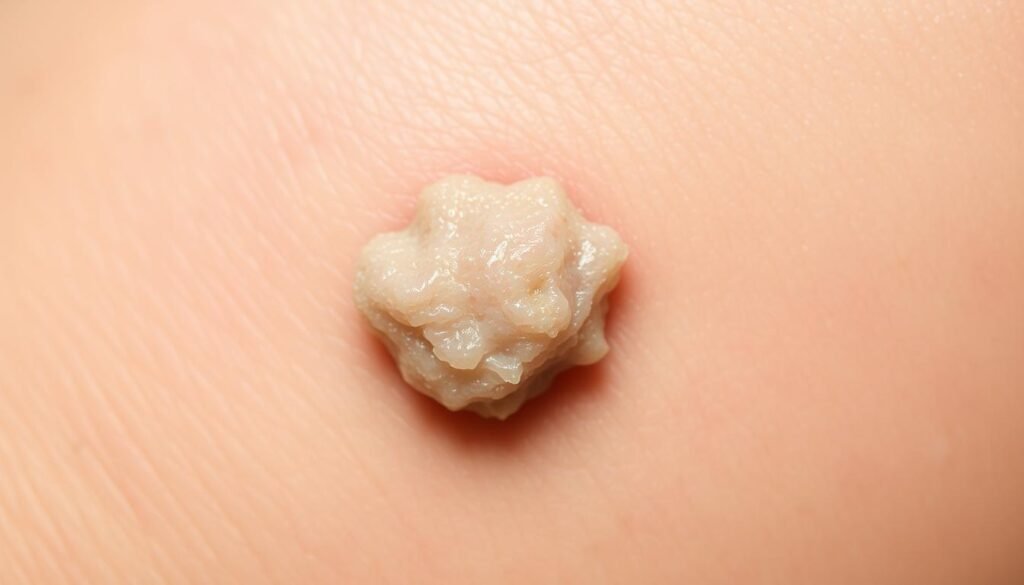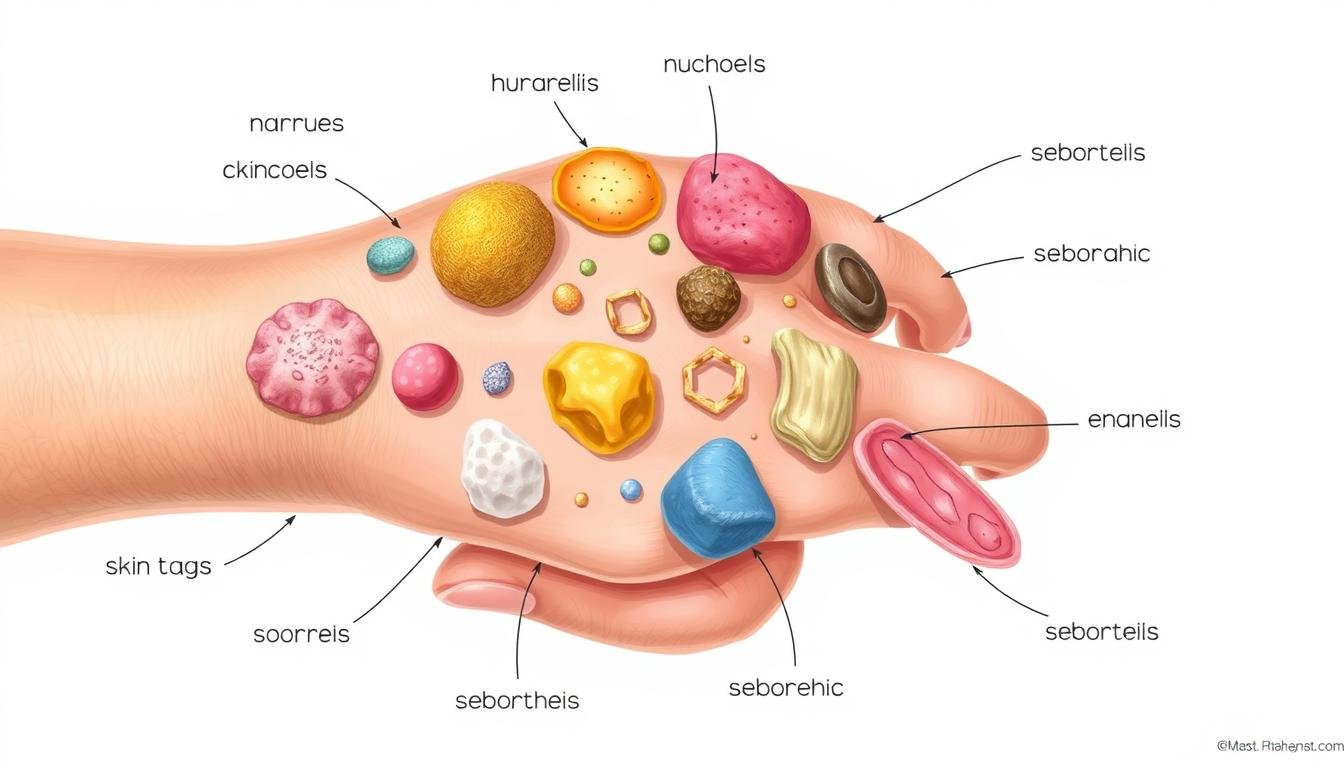When I first saw a small bump on my skin, I panicked. Many of us worry about the worst when we notice something new. Our skin is always changing, and knowing about skin growths helps us stay calm.
Skin growths are very common and usually harmless. They can pop up anywhere on our body, from small moles to bigger lumps. Even though they might look scary, most are just normal parts of our body’s cycle.
Learning about different skin growths helps us know when to worry. From simple skin tags to more serious skin issues, knowing what’s normal is key to keeping our skin healthy.
Key Takeaways
- Most skin growths are benign and non-cancerous
- Regular skin examinations can help detect problems early
- Skin growth types vary widely in size, shape, and appearance
- Epidermal renewal is a natural, ongoing process
- Professional dermatological consultation is recommended for unfamiliar skin changes
Introduction to Skin Growths and Their Impact on Health
Our skin is a complex organ that changes all the time. Dermal repair and collagen production are key to keeping it healthy. Knowing about skin growths helps us spot and prevent serious problems early.
Skin growths are unusual skin changes that can look different and have varying health effects. They can be caused by genetics, the environment, and our health.
What Defines a Skin Growth
A skin growth is marked by:
- Unexpected changes in skin texture
- Unusual color variations
- Alterations in size or shape
- Potential discomfort or sensitivity
Common Locations for Skin Growths
Skin growths often pop up in sun-exposed or friction-prone areas, like:
- Face and neck
- Arms and shoulders
- Trunk and back
- Lower legs
Initial Signs and Symptoms
Spotting early signs is key to managing them well. Look out for:
- Color changes: Unexpected pigmentation shifts
- Texture modifications: Rough or uneven surfaces
- Physical sensations: Itching, burning, or tenderness
“Early detection of skin changes can be a critical step in maintaining overall skin health.” – Dermatology Research Institute
Skin cancer affects 1 in 5 Americans at some point. Understanding skin growths is vital. Our skin’s collagen and repair systems help manage and prevent problems.
Benign vs. Malignant Skin Growth: Key Differences
It’s important to know the difference between benign and malignant skin growths. Most are harmless, but some can be serious. Our skin’s elastin synthesis and wound healing are key in how these grow and act.
“Knowledge is the first line of defense in skin health management.”
Benign skin growths have some common traits:
- They grow slowly and stay the same size
- They don’t spread to other parts of the body
- They look pretty predictable
- They usually don’t cause big health problems
Malignant growths, on the other hand, grow fast and can spread. About 1 in 5 people in the U.S. will get skin cancer. This shows why finding them early is so important.
Skin lesions can come from injuries, infections, or genes. How our skin heals and makes elastin affects these growths.
Signs of a bad growth include:
- They’re not symmetrical
- They have uneven edges
- They change color
- They’re bigger than 6mm
- They look different over time
Getting regular skin checks and seeing a dermatologist is the best way to handle skin growths.
Most Common Types of Skin Tags and Moles
Skin growths are a natural part of our body’s development. Some are more common than others. Knowing about skin tags and moles helps us take care of our skin. It also helps us use the right anti-aging skincare.
Characteristics of Skin Tags
Skin tags are soft, harmless growths that show up in skin folds. They are very common, affecting about half of adults. Key locations for skin tags include:
- Neck
- Armpits
- Groin area
- Under breasts
Different Types of Moles
Moles are colored spots on the skin that appear over time. Most adults have between 10 and 40 moles. Most of these appear before age 25. Moles can be different types:
| Mole Type | Characteristics | Risk Level |
|---|---|---|
| Congenital Nevi | Present at birth | Low-moderate |
| Dysplastic Nevi | Larger than pencil eraser, irregular shape | Higher melanoma risk |
| Junctional Moles | Flat, uniformly colored | Low |
Risk Factors and Development
Many things can affect how skin grows, like age, genetics, and sun exposure. For the best skin health, we suggest:
- Regular skin checks
- Protecting skin from UV rays
- Sticking to a good skincare routine
“Know your skin and watch for changes – catching issues early is key to managing them.”
Understanding Seborrheic Keratosis

Seborrheic keratosis is a skin growth that many people get as they age. It’s not cancerous and is very common, mostly in people over 50. These growths look like small, waxy patches stuck to the skin.
There are a few important things to know about these growths:
- They can be different colors, from light tan to black
- They can grow up to 1 inch across
- They often show up on the face, back, chest, and shoulders
- They are linked to aging and skin renewal
“Seborrheic keratoses are like nature’s unique signatures on our skin, marking the passage of time.” – Dermatology Insights
Even though they’re not harmful, they can sometimes bother people or cause mild irritation. If you have a family history of them, you might be more likely to get them. Doctors can remove them with treatments like cryotherapy and laser therapy.
It’s a good idea to watch for any changes in size, color, or texture. This could mean you need to see a doctor. As we age, our skin changes, and seborrheic keratoses are a natural part of that.
Dermatofibromas and Their Characteristics
Dermatofibromas are interesting skin growths that catch the eye of both doctors and patients. They are small, harmless tumors that show how our skin regenerates and repairs itself.
Identifying Dermatofibromas
These skin lesions have unique features that make them stand out. They are found in about 3% of skin samples and mostly appear in people between 20 and 50 years old.
- Size range: 0.5 to 1.5 centimeters
- Color variations: Pink, red, gray, brown, or black
- Most frequent locations: Arms, lower legs, and upper back
Diagnostic Features
A key sign of dermatofibromas is the dimple sign. When pressed gently, the growth looks like it’s pulling in, creating a small dent. Women might be more likely to get these growths than men.
Treatment Options
Even though dermatofibromas are usually harmless, some people might want them removed for looks or if they’re uncomfortable. The best way to get rid of them is surgery, but it can leave scars.
- Surgical excision
- Liquid nitrogen freezing
- Corticosteroid injections
Prevention and Monitoring
Knowing how our skin repairs itself can help us keep an eye on any changes. Only 20% of people say they got their growth from an injury, showing it’s a complex process.
Always see a dermatologist if you notice any new or changing skin growths. They can help with the right diagnosis and care.
The Role of Age in Skin Growth Development
As we get older, our skin changes a lot. These changes affect how skin growths develop. Over 90% of older people have some skin disorder.
Collagen and elastin are key for skin health as we age. Our skin can’t repair itself as well as it used to. This makes it more likely for skin growths to appear.
Key Age-Related Skin Changes
- Decreased collagen production leads to skin thinning
- Reduced elastin synthesis causes decreased skin elasticity
- Slower cellular repair mechanisms
- Changes in oil production
Some skin growths are more common with age. Skin tags, warts, and seborrheic keratoses are common in middle-aged and older people. Cherry angiomas, benign vascular growths, also increase with age.
“Skin aging is a complex interplay of intrinsic and environmental factors that collectively influence skin health and growth development.”
Exposure to the sun speeds up aging. People with fair skin show aging changes more. Sun-exposed areas change more than others.
Sun Exposure and Its Effect on Skin Growths
Keeping our skin safe from the sun is key to healthy skin and avoiding unwanted growths. The sun’s UV rays can harm our skin, causing various problems and speeding up aging.
UV Radiation’s Impact on Skin
UV rays can damage skin cells, leading to health issues. Our research shows some alarming facts about sun-related skin risks:
- Over 2 million Americans are treated annually for basal and squamous cell carcinoma
- More than 68,000 melanoma cases are diagnosed each year
- Cumulative sun exposure increases skin cancer risk dramatically
Protective Measures for Skin Rejuvenation
Using good skincare can help fight sun damage. Here are some key steps:
- Use broad-spectrum sunscreen with SPF 30 or higher
- Wear protective clothing
- Stay out of the sun during peak hours
- Check your skin often for unusual growths
Treatment for Sun-Induced Growths
When sun damage happens, there are ways to fix it. Dermatologists use different methods to treat sun-induced growths, including:
| Treatment Method | Effectiveness |
|---|---|
| Cryotherapy | High for small growths |
| Surgical Excision | Recommended for larger or suspicious growths |
| Laser Removal | Precise treatment for specific skin conditions |
“Prevention is always better than cure when it comes to sun damage and skin health.” – Dermatology Experts
Our approach to skin care focuses on early action and ongoing care. By knowing the dangers of UV rays and using good skincare, we can manage and reduce skin growth problems.
Skin Growth Prevention and Early Detection
Protecting your skin is key to keeping it healthy. With over 1 million new skin cancer cases in the U.S. each year, it’s vital to know how to prevent it. This helps keep your skin in top shape.
Our skin is the biggest organ in our body. Catching problems early can greatly improve treatment results. We suggest using these skin protection tips:
- Perform monthly self-examinations
- Schedule annual dermatologist consultations
- Monitor changes in skin texture and appearance
- Protect against ultraviolet radiation
“Regular skin checks can make the difference between early intervention and advanced disease progression.”
Keeping your skin healthy involves supporting its natural renewal. This makes your skin stronger against growths. Also, helping your skin heal from wounds keeps it intact and helps spot any odd changes.
| Prevention Strategy | Key Benefits |
|---|---|
| Regular Self-Examinations | Early detection of possible skin changes |
| Sun Protection | Lessens UV-related skin damage |
| Healthy Lifestyle | Boosts natural skin renewal |
Look out for warning signs like new growths, changes in moles, and sores that won’t heal. Staying alert and taking action can greatly lower the risk of skin problems and cancers.
Treatment Options for Various Skin Growths
Dealing with skin growths needs a plan that fits each growth’s type, where it is, and its details. Our guide looks at the best ways to treat different skin issues. It aims to reduce scars and help skin cells grow back.
Dermatologists use many ways to safely and effectively treat skin growths. Specialized medical centers offer treatments made just for each patient.
Surgical Removal Techniques
Here are some surgical methods for removing skin growths:
- Excision: Completely cutting out the growth
- Curettage: Scraping the growth with a special tool
- Electrocautery: Burning off the growth with electrical current
Non-Invasive Treatments
Non-surgical options aim to lessen harm to skin cells:
- Cryotherapy: Freezing growths with liquid nitrogen
- Laser treatments: Targeting specific skin layers
- Topical medications: Using special creams
Recovery and Aftercare
Good care after treatment is key for healing and reducing scars. We suggest:
- Keeping the treated area clean and safe
- Using the right ointments
- Avoiding direct sun
- Following doctor’s advice
*Healing time changes based on treatment and skin response.*
| Treatment Method | Average Healing Time | Scar Reduction |
|---|---|---|
| Cryotherapy | 1-2 weeks | Moderate |
| Surgical Excision | 2-4 weeks | High |
| Laser Treatment | 7-10 days | High |
We focus on making patients comfortable, using methods that are as gentle as possible, and helping skin cells grow back well.
Natural Remedies and Home Care for Skin Growths
Managing skin growths needs a whole-body approach to skin care. Getting medical advice is always important. But, many natural remedies can help with anti-aging and minor skin issues.
“Prevention and gentle care are key to maintaining healthy skin.” – Dermatology Insights
We focus on natural ways to handle skin growths. Here are some key methods:
- Gentle topical treatments using natural ingredients
- Dietary changes that help skin health
- Stress reduction techniques
- Proper hydration and nutrition
Natural ingredients are great for skin care. Aloe vera soothes irritated skin. Tea tree oil fights bacteria. Apple cider vinegar helps with minor skin issues.
Our lifestyle affects our skin a lot. Eating well, drinking water, and managing stress are key. Exercise and sleep help our skin too.
“Your skin reflects your overall health and wellness.” – Holistic Dermatology Research
Here are some home care tips:
- Always talk to doctors before trying home treatments
- Watch skin growths for size, color, or texture changes
- Keep skin safe from too much sun
- Stick to a skincare routine
Remember, natural remedies are great for skin health. But, they can’t replace a doctor’s check-up, for sure.
When to Seek Professional Medical Help
Keeping an eye on your skin is key. Knowing when to see a dermatologist can stop problems before they start.
Critical Warning Signs
Our doctors say to see a pro right away if you notice:
- Rapid changes in skin growth appearance
- Persistent pain or bleeding around a growth
- Unexplained itching or discomfort
- Signs of possible infection like redness or warmth
Emergency Situations
Some skin issues need quick action. Skin cancer is the most common cancer in the U.S. It affects up to 30% of Caucasians at some point.
“Early detection significantly increases complete recovery chances for skin-related conditions.”
Finding the Right Specialist
Look for a dermatologist who’s board-certified. They know how to handle tough skin problems.
We help patients in Florida, like Orlando, Clermont, and The Villages. Call us at +1(352) 565-7575 for top-notch skin checks.
Don’t forget to check your skin monthly. And get a professional check-up every 6-12 months to keep your skin healthy.
Latest Advances in Skin Growth Treatment

Medical science is making big strides in skin growth treatment. We now know a lot more about how skin cells grow and collagen is made. This is great news for people with tough skin problems.
Recent studies show some exciting ways to handle skin growths:
- Photodynamic therapy targeting specific cellular mechanisms
- Advanced laser treatments with precision targeting
- Molecular therapies focusing on genetic interventions
Regenerative medicine is key in keeping skin healthy. Scientists are working on new ways to help skin heal itself. These methods aim to increase collagen and fix skin better.
“The future of skin growth treatment lies in personalized, targeted interventions that understand each patient’s unique genetic makeup.” – Dermatological Research Institute
New clinical trials are showing great results. For example, treatments that target specific genetic changes are working well for tough skin issues.
| Treatment Approach | Key Advantages | Patient Outcomes |
|---|---|---|
| Targeted Molecular Therapy | Precision targeting | Improved recovery rates |
| Immunotherapy | Enhanced immune response | Reduced recurrence |
| Regenerative Medicine | Natural healing stimulation | Minimal scarring |
These new findings are very promising. But, we must make sure they are proven to work safely. Our doctors are all about using treatments that are backed by solid evidence. They want to make sure patients are safe and healthy in the long run.
Lifestyle Factors Affecting Skin Growth
Our lifestyle choices greatly affect our skin’s health and renewal. How we live, eat, and take care of ourselves impacts our skin’s aging and growth.
Several key lifestyle factors significantly influence skin health:
- Diet and nutrition
- Stress management
- Sleep quality
- Physical activity
- Environmental exposures
Nutrition is key for skin health. Eating foods rich in antioxidants and omega-3 fatty acids helps. But, too much sugar can harm your skin.
“Your skin reflects your overall health and lifestyle choices” – Dermatology Experts
Smoking and drinking alcohol hurt your skin a lot. Smoking cuts off blood flow and breaks down collagen, leading to early aging. Studies show smokers’ skin ages faster than non-smokers.
Exercise is good for your skin. It boosts blood flow and helps skin cells renew. Regular workouts bring nutrients and oxygen to your skin, making it look better and stronger.
Things like sun, pollution, and extreme weather can damage your skin. To keep your skin healthy, use sunscreen, stay hydrated, and make smart lifestyle choices.
Genetic Predisposition to Skin Growths
Genetic research has changed how we see skin growths. Genetics play a big role in who gets certain skin conditions. Some inherited syndromes raise the risk of specific skin growths and health problems.
Some genetic conditions show clear patterns in skin issues. For example, research in dermal repair shows Birt-Hogg-Dubé syndrome increases kidney cancer risk seven times. Also, 80% of those with it have lung cysts. This shows how genes and skin health are connected.
Hereditary Factors in Skin Growth Development
Looking at family history can help predict skin growth risks. For example, hereditary leiomyomatosis leads to skin growths in 76% of people by age 25. Rare syndromes like Cowden syndrome affect about 1 in 200,000 people. This shows how unique genetic risks can be.
Family History and Genetic Testing
Knowing your family’s health history can help predict skin growth risks. Genetic tests now give us deep insights, like for melanoma. They show that 35% to 40% of familial cases have specific genetic changes. This makes our approach to skin health more personal, using genetic info for better prevention and treatment.




